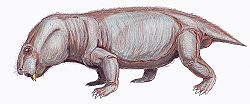This article relies largely or entirely on a single source .(August 2024) |
| Oudenodontidae Temporal range: Late Permian | |
|---|---|
 | |
| Oudenodon | |
| Scientific classification | |
| Domain: | Eukaryota |
| Kingdom: | Animalia |
| Phylum: | Chordata |
| Clade: | Synapsida |
| Clade: | Therapsida |
| Suborder: | † Anomodontia |
| Clade: | † Dicynodontia |
| Clade: | † Cryptodontia |
| Family: | † Oudenodontidae Cope, 1871 |
| Genera | |
Oudenodontidae is an extinct family of dicynodont therapsids, known from the Late Permian of Malawi, Namibia, Russia, South Africa, Tanzania, and Zambia. [1] [2] It includes three genera, Australobarbarus , Oudenodon , and Tropidostoma . [3] [4]





